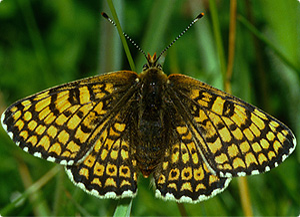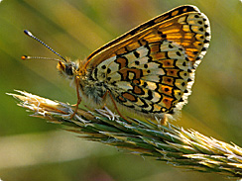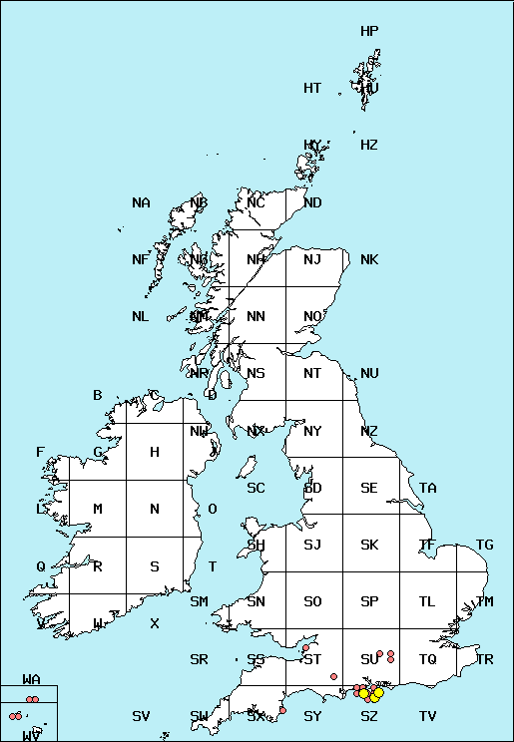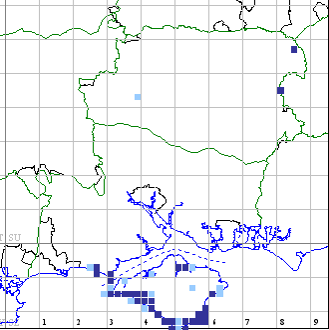Memorable moments with nature: Warden Mike
On June 4th 2010, in my capacity as a Ranger with English Heritage, I spent a day at Osborne House on the Isle of Wight advising staff on the creation of a wildflower meadow and on how to set up a Butterfly Recording Transect in the grounds of the estate. My day’s work complete, I trundled off in my 1973 VW Camper Van to camp at Grange Farm, Brighstone Bay, on the island’s south coast.
That evening, just as I began to walk from the cliff-top campsite down to the beach along a shallow valley (known as a ‘chine’), a peculiar movement in the vegetation caught my eye. Taking a closer look, I realised that it was a butterfly emerging from its chrysalis – something I had never before witnessed. After a minute or so observing this miracle of nature, my excitement escalated still further upon the realisation that this butterfly was a Lady Glanville’s Fritillary – one of Britain’s rarest butterflies! ‘How lucky I am to finally see one for the first time ever!’ thought I. But my luck didn’t stop there because over the next 20 minutes, as I slowly made my way down to the beach, I stopped counting at 101. Yes, you read that correctly: one hundred and one Lady Glanville’s Fritillaries! It seemed that I had stumbled upon a major event, timed absolutely perfectly. Nearly all of these butterflies looked as though they had recently emerged from their chrysalis stage; and, indeed, I saw three more emerging, drying their wings, perched on Buckthorn Plantain.
Although I stopped counting at 101, there were so many more; and it seemed that word of this super-abundance had circulated amongst the local bird population because I witnessed, with some alarm, the unnerving sight of a dozen house sparrows, several winchats, rock pipits and pied wagtails catching them in their beaks with great ease – having a field-day of a feast.
I returned to my VW Camper Van at the cliff-top campsite, dazed and dumfounded by the spectacular sight of a nationally rare butterfly – commonplace in this coastal valley!
Lady Glanville’s Fritillary – Melitaea cinxia


(Credit: Sam Ellis)
Flight period: May/June
Habitat: coastal grasslands either on undercliffs where there is soil slippage, deeply incised coastal river valleys (chines) with eroding sides, or cliff tops; and south facing chalk downland. Mainly on the southern half of IOW.
Larval foodplant: Ribwort Plantain, Buck’s-horn Plantain.
Distribution maps:

Courtesy of https://www.ukbutterflies.co.uk/distribution.php?species=cinxia

Courtesy of Sam Ellis of Butterfly Conservation
As can be seen by the maps above, the distribution of this butterfly is extremely limited; but it wasn’t always so. The species is named after Lady Eleanor Glanville (1654 to 1709) who was the first person to identify it – in Lincolnshire!
In those days it was considered a sign of madness for a woman to wander around the countryside collecting butterflies, and in 1698 her estranged husband, Sir Richard Glanville, tried to get his hands on Lady Eleanor’s inherited fortune by seeking to have her declared a ‘lunatic’. He failed, but after her death, her last will and testament was overturned by her son on the grounds that she was insane because of her interest in butterflies!
Photos/flight period/habitat/larval foodplant & IOW distribution map: special thanks to Sam Ellis of Butterfly Conservation.
Warden Mike
